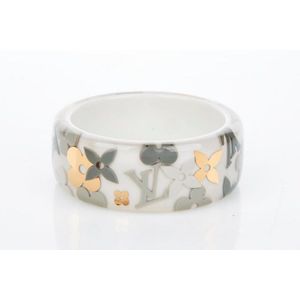LV Lucite Bangle with Gold Inclusions and Dust Pouch
You must be a subscriber, and be logged in to view price and dealer details.
Subscribe Now to view actual auction price for this item
When you subscribe, you have the option of setting the currency in which to display prices to $Au, $US, $NZ or Stg.
- Ivory - Ivory is a hard white material that comes from the tusks of elephants, mammoth, walrus and boar, or from the teeth of hippopotamus and whales. The ivory from the African elephant is the most prized source of ivory. Although the mammoth is extinct, tusks are still being unearthed in Russia and offered for sale.
Ivory has been used since the earliest times as a material for sculpture of small items, both in Europe and the east, principally China and Japan.
In Asia ivory has been carved for netsuke, seals, okimono, card cases, fan supports, animals and other figures and even as carved tusks.
In the last 200 years in Europe ivory has been used to carve figures, for elaborate tankards, snuff boxes, cane handles, embroidery and sewing accessories, in jewellery and as inlay on furniture. Its more practical uses include being used for billiard balls, buttons, and a veneers on the top of piano keys.
The use and trade of elephant ivory have become controversial because they have contributed to Due to the decline in elephant populations because of the trade in ivory, the Asian elephant was placed on Appendix One of the Convention on International Trade in Endangered Species (CITES), in 1975, and in January 1990, the African elephant was similarly listed. Under Appendix One, international trade in Asian or African elephant ivory between member countries is forbidden. Unlike trade in elephant tusks, trade in mammoth tusks is legal.
Since the invention of plastics, there have been many attempts to create an artificial ivory - Lucite - Lucite was invented in 1931 by chemists at DuPont. It was crystal clear, resistant to water and UV rays, and was low density yet stronger than previous plastics. Like Bakelite, Lucite was used extensively in war supplies during WWII.
After the war, the plastics were used for jewellery and other items. Lucite rings were highly popular during the '50s and '60s, as were Lucite handbags. In 1993, DuPont sold its acrylic resin operations, and the Lucite name now belongs to Lucite International in Southampton, UK.
This item has been included into following indexes:
Visually similar items

Japanese blue and white porcelain chawan (teabowl), painted with a scrolling dragon. Height 8.5 cm

A small Chinese tea cup, finely decorated with five red crested cranes in underglaze blue flying above emerald waves, with an apocryphal underglaze Yongzheng mark underside, height 5 cm, diameter 6.5 cm

A large Chinese porcelain bowl, blue and white with peach design and brass fittings around rim. Height 18 cm, diameter 31 cm

A Chinese export porcelain famille rose cream jug, Qianlong 18th century, 10 cm high and a Qingbai twin fish dish 18 cm diameter
